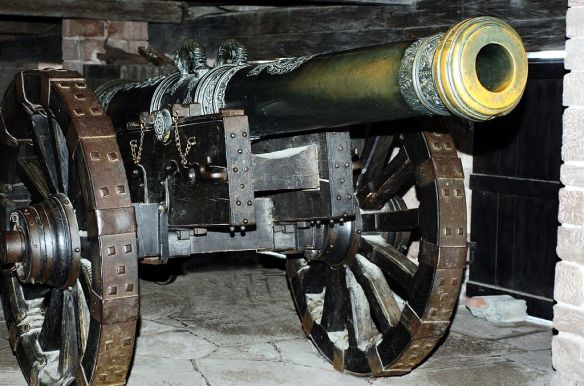Cannone nel castello di Haut-Koenigsbourg
Various 16th-century artillery pieces, including culverin, falconet and mortar.
The word cannon comes from the Greek kanun, meaning a tube. One early surviving cannon was an octagonal tube with a round bore. It had a breech block hammered in to place during casting. Cuprum and latten, both forms of brass, were used to make guns. But soon it was clear that cast iron was the best material. At first cannons were either placed on a mount to point them upwards or tied to a wooden board in order to tip the weapon and aim it by placing wedges underneath. In the fifteenth century one finds trunnions (wheeled platforms) in use. Cannons were loaded either by a mobile chamber or thunder-box, or else at the breech. The chamber was filled with gunpowder and a heated touch applied to the hole in the tube or the touch-hole. The chamber was closed with a bung of soft wood to act as a wad between the charge and the shot. The bung would pop out like a cork, the idea being that the chamber itself should not explode. The mobile chamber was placed in the breech and clamped with an iron rod, then packed with tow. By the middle of the fifteenth century some very large cannons were being manufactured.
In France, the Bureau brothers devised the artillery camp, an entrenchment full of guns of all sizes. This proved itself at Castillon, in 1453, the battle which saw the expulsion of the English from Aquitaine. The dukes of Burgundy were also great exponents of gunpowder weapons, although it was only in the 1470s that Charles the Bold had a substantial force of ‘field guns’ .Against conventional armies they were useful, because the new wheeled guns could be moved around and placed in different positions. However, the Swiss often moved too quickly for the cannon to be effective. Charles also inherited a force of handgunners. That he should have bothered to maintain large numbers of these indicates their effectiveness. Late medieval armourers had responded to the challenge of ever more powerful crossbows and massed longbows by producing a better design, resulting in a revival of knightly cavalry on armoured horses. However, the fluted armours and hardened steel that cleverly directed arrows and quarrels away were scant protection against handgunners. Intermingled or operating in front of dismounted men-at-arms and halberdiers, they were useful for sniping at enemy leaders and bringing down the armoured front ranks of pike formations. This also explains why handgunners were included in the mercenaries hired to participate in the Wars of the Roses. Despite all these developments, cannon and handguns do not seem to have exercised a decisive influence on the outcome of field battles until the sixteenth century.
“Cannon” was later confined to mean a specific class of gun that fired heavy shot over relatively short distances. These second-generation weapons normally had cast barrels, rather than barrels assembled by the hoop-and-stave method used in crafting early bombards. By the 16th century basic cannon were relatively standardized. They could hurl 50-pound solid shot to an effective hitting range of 600 yards, and a maximum (though largely ineffective) throwing range of 3,500 yards. At sea, cannon remained inaccurate dueling pieces when used at long range. This fact midwifed the phrase “long shot,” in reference to the high risk of firing at a distance without real effect, which allowed one’s enemy to close before a cannon could be reloaded. Cannon proved to be adept ship-killers at close ranges. On land, they were powerful siege weapons, though unwieldy even when mounted, without much mobility, and hence of little use in battle. Firing 1,000 rounds from a battery of full cannon consumed 32,000 pounds of iron shot and 20,000 pounds of powder. This presented a massive logistics problem to any early modern army seeking to move its guns. Other large caliber guns classed as “cannon” (as opposed to long-barreled culverins or stubby mortar types) included: basilisk, cannon-royal, cannon-serpentine, demi-cannon, and quarto-cannon.
